
9.09.2005
Central Parks 2

Central Park Zoo
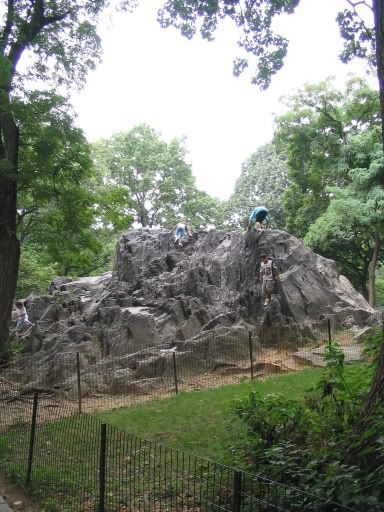
Central Park Rocks

Bethesda Fountain

The Great Lawn and beyond from the Belvedere Castle
8.30.2005
Summer in NY
Here are some pictures of the stuff I worked on:


Okay, I know it isn't much, I'm still perfecting the art of collage. If you haven't figured it out, it's about pollution mitigating urban design. Something that you would definitely need along EDSA, Aurora Boulevard, or any major urban thoroughfare if you don't want your kids to develop asthma and other respiratory diseases while growing up in the city.
If there is one thing I'm learning to do all over again is to be a hard-nosed idealist. And this is a good place to do it. So I'm glad.
Okay, that's enough for today. Time to go out and see the rest of the city... or maybe some sleep... Yeah, I've been missing that too. Well, there's enough time to do both! Until next time...
8.07.2005
What's gone and what's still there

Seagram Building
A couple at the Seagram Plaza
Seagram Plaza

The former World Trade Center Site
Visitors to the former World Trade Center

Barriers in Public Space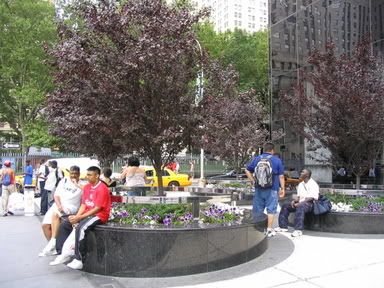
Plant boxes or additional security measures?
7.21.2005
42nd Street

The American Airlines Theatre

Bryant Park

New York Public Library

Chrysler Building
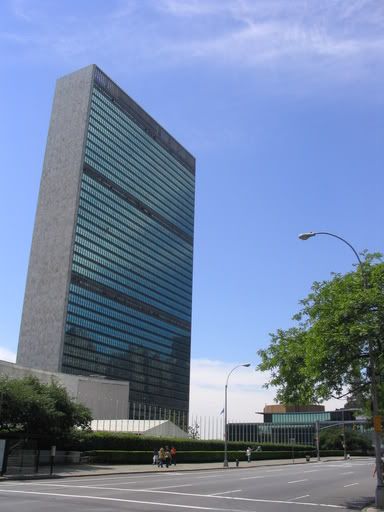
United Nations Headquarters
6.25.2005
The Cathedral Church of St. John the Divine

The world's largest (unfinished) Gothic Cathedral

Even without the spires, it's huge.
I bought my first New York hotdog by the church steps for one dollar. It was fine, but hotdogs taste the same wherever you go.
6.18.2005
Central Parks

Harlem Meer, the little "sea" in the park

A quaint little house by the lake

Spring in New York

Purple fluff
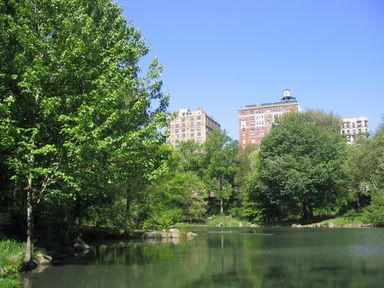
The city (and my laundry) beckons...
Central Park has a nice mix of trees and wide open spaces, but I think that the Tiergarten in Berlin is still a better park to enjoy getting lost in :)

Tiergarten in Berlin
6.06.2005
Welcome to my neighborhood

The place to talk about nothing...
5.25.2005
The People You Meet on the Plane

5.23.2005
Planes and Terminals
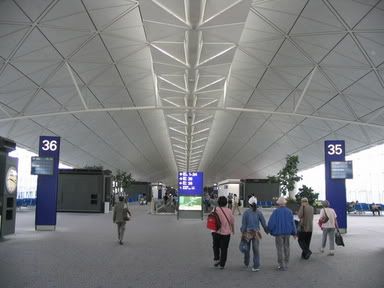
Traveling halfway across the world is quite an experience. It takes extremely long and requires a lot of walking. Despite the numerous benefits of modern air travel, travelers must still rely on their own two feet, especially when in transit, to get to where they are going. Having such a huge number of people flying all over the world requires massive airport terminals, and large airport terminals mean lots of walking from one gate to the next. Such is the case when I visited the Hong Kong International Airport. The terminal is beautiful to look at, no doubt, but hard on the heels. I walked for almost an hour, taking a few snapshots along the way of course, while standing on moving walks (never have I appreciated the technology of a moving walk as much as I did then). As for my thoughts on the terminal itself, I would say that airports should efficiently drive you to your destination without any hesitation. The more fleeting the experience, the better. It is only when relaxing at the gate lounge that you will have the time to contemplate the beauty of the details that a few minutes ago were just a blur in the periphery of your vision, preferably without noticing the wear in your shoes and the ache in your legs.
5.17.2005
Sorry, I can't help it :)
I'm leaving today...
5.11.2005
Blog Link 2: Staring at the Bright Blue Sky
Read it by clicking on the title of this post.
4.30.2005
Honrado Fernandez
Despite being a man of many talents, I feel that Dean Fernandez was first and foremost an educator. He brainwashed entire batches of architecture students to keep the fires of indigenous art and architecture burning through his unique ability to inspire both guilt and pride in what would otherwise be taken for granted. Though many flames were inevitably doused, some embers still smolder in the hope of catching flame once more. I think I still keep a tiny ember of his making, fueled by rememberance and protected by sentiment.
May his memory live on.
4.22.2005
Blank Screen
3.28.2005
I've been tagged
I have never been tagged before, so here goes...
You're stuck inside Fahrenheit 451. What book do you want to be?
Farenheit 451 is the temperature that paper starts to burn. In Ray Bradbury's story, the "firemen" did not stop fires, they burned books to discourage independent thought. If I want to make a difference and go in a blaze of glory, I would like to be Charles Darwin's Origin of the Species. However, if I want to effect change yet survive a regular neighborhood book burning, I would like to be a dictionary, pretty harmless by itself yet capable of bringing forth great ideas in the right hands.
Have you ever had a crush on a fictional character?
To satisfy the (perverse) curiosity of the one who tagged me, I especially liked Dr. Arroway in Carl Sagan's Contact. (It also helps that Jodie Foster played her in the cinematic version later on.)
The last book you bought is...
Aldous Huxley's Island
Five books you would take to a deserted island:
1. A survival guide (preferably one written for castaways on deserted islands)
2. A gourmet cookbook for seafood or whatever's edible on a deserted island
3. An entertaining book about the true-to-life experiences of a real castaway, so I won't feel particularly unfortunate.
4. A compendium of different world religions. When I'm not busy chasing crabs and harvesting coconuts, I'll probably wonder about my place in the cosmos.
5. A book on sailing and navigation, just in case I get tired of the seclusion and decide to return to civilization.
What are you currently reading?
Jane Jacobs' The Death and Life of Great American Cities. Why didn't they teach us all this in college?
Who are you going to pass this stick to and why?
Yo and Ferdz. They read very curious books.
3.23.2005
The Other Metropolis
I have traveled to different parts of the country, but mostly on short vacations, tours, or site visits. However, I never experienced working for an organization based in another distinct city until I went to Cebu on a teaching assignment.

That's me in the airport admiring the shiny floor

There's the gate lounge and some airport employees amused by a camera-toting pseudo-Japanese tourist

The plane I thought I would be on until they changed gate assignments at the last minute
Cebu was a pleasant surprise, every bit as urban as Metro Manila minus the traffic and the crowds, more comprehensible in scale as a city, at least an hour away from pristine mountain and shore, and full of nice friendly people.

Not my aerial photo but you get the idea - Cebu City
Unfortunately, I did not get around much since my classes were back to back, but i did manage to sample some of the local food, experience a bit of the relaxed nightlife, drive through the city, and live for a couple of days with the very friendly and considerate extended family of my friend and teaching colleague.
Cebu is a wonderful city and metropolis of its own right. Metro Manila, though much larger and more diverse, is a sad comparison in terms of livability and lovability. What makes a city great is not how many people or how much economic activity it generates, but how much it makes you want to stay and explore the possibilities. I would sure like to go back someday soon.
3.16.2005
Blog Link 1: Pointyman2000
Read it by clicking on the title of this post.
3.06.2005
Is this possible?
| You Are 50% Left Brained, 50% Right Brained |
| The left side of your brain controls verbal ability, attention to detail, and reasoning. Left brained people are good at communication and persuading others. If you're left brained, you are likely good at math and logic. Your left brain prefers dogs, reading, and quiet. The right side of your brain is all about creativity and flexibility. Daring and intuitive, right brained people see the world in their unique way. If you're right brained, you likely have a talent for creative writing and art. Your right brain prefers day dreaming, philosophy, and sports. |
3.04.2005
Solo Flight Around the World!

The Virgin Atlantic Globalflyer piloted by Steve Fossett at the conclusion of the fastest, non-stop, non-refuelled solo flight around the world
2.27.2005
Aldous Huxley's Island

"About twenty on the average."
"Twenty? My God!"
"We all belong," Susila explained, "to a MAC -a Mutual Adoption Club. Every MAC consists of anything from fifteen to twenty five assorted couples. Newly elected brides and bridegrooms, old timers with growing children, grandparents and great-grandparents everybody in the club adopts everyone else. Besides our own blood relations, we all have our quota of deputy mothers, deputy fathers, deputy aunts and uncles, deputy brothers and sisters, deputy babies and toddlers and teen-agers."
Will shook his head. "Making twenty families grow where only one grew before."
"But what grew before was your kind of family. As though reading instructions from a cookery book, "Take one sexually inept wage slave," she went on, "one dissatisfied female, two or (if preferred) three small television addicts; marinate in a mixture of Freudism and dilute Christianity, then bottle up tightly in a four room flat and stew for fifteen years in their own juice. Our recipe is rather different: Take twenty sexually satisfied couples and their offspring; add science, intuition and humor in equal quantities; steep in Tantrik Buddhism and simmer indefinitely in an open pan in the open air over a brisk flame of affection."
"And what comes out of your open pan?" he asked.
"An entirely different kind of family. Not exclusive, like your families, and not predestined, not compulsory. An inclusive, unpredestined and voluntary family. Twenty pairs of fathers and mothers, eight or nine ex-fathers and ex-mothers, and forty or fifty assorted children of all ages."
Island is a work of utopian fiction set in (believe it or not) Southeast Asia. It is my first book by Aldous Huxley (unless you consider watching the movie A Brave New World akin to reading the book) and I am thoroughly impressed. Though Huxley appears to be quite fond of fantastic drug-induced mental states, I would say that his ultimately tragic vision of the nation of Pala is one of the best fictional constructions of utopian society I have read thus far. The story of the island nation is wonderfully appealing, yet the events that transpired are almost real, like something that could have happened in the region in our very recent history.
The book was written two years before Aldous Huxley died and is often considered the culmination of his utopian/dystopian writings starting with A Brave New World. Huxley envisioned a hopeful alternative to the world we have today, a human society that paid "attention" to the "here and now," and by doing so, found happiness in the most mundane.
2.22.2005
Interactive Feng Shui Adviser
2.21.2005
I'm writing some more!
from My Home Magazine February 2005 Issue
So, how does one transform the common bathroom into more than just another utilitarian space? The most versatile and responsive baths share a number of fundamental characteristics: ample space, light, air, water, and privacy. Together, these qualities contribute to a more holistic bathing experience, a far cry from the regular shower.

More Space
Added space, whether physically accessible or just the mere sight of it will surely enhance the bather’s sense of well-being in this often most claustrophobic of rooms.
In a spacious bath, one may stretch out comfortably without tipping bottles or striking fixtures by accident. Of course, not many bathrooms pass this criterion, but there are ways to transform seemingly small spaces into larger ones. One method is to simply reduce clutter by relocating items that do not contribute to the bathing experience. The remainder may then be stored inside built-ins, preferably beneath the sink or flush with the walls for a cleaner look. Another way is to use curtains instead of panels. Curtains allow the freedom of movement often lacking in small showers without sacrificing privacy. One more technique is to integrate curves into the design. Curved surfaces look more fluid, thus adding a sense of depth to an otherwise tiny space.
If practicable, the bathroom may be physically extended into an adjacent area, like a neighboring bath, closet, bedroom, garden wall, light well, balcony, or even part of the hall. A visual link between different areas and borrowed scenery will also add to the bather’s sense of space. If no adjoining rooms are available, an illusion of additional space may be fabricated through the clever use of mirrors or translucent surfaces.
More Light and Air
A well-lighted bathroom encourages activities usually overlooked in no-frills bathing like reading, appreciating art, and catching some rays. Windows, glass panel doors, skylights, reflective surfaces, and artificial lighting can help brighten up the room. However, indirect light is often favored over direct light to avoid heat and glare.
Since more time is to be spent inside the bathroom, the space must also be well ventilated like a regular room. Water makes the air humid, so if items such as art pieces or books are to find a place in the bath, items must be protected and humidity must be controlled by good ventilation usually through operable windows or quiet exhaust fans.
More Water
Tubs are notorious for consuming excessive amounts of water, but a mere dip need not be wasteful if done correctly. In traditional Japanese baths, bathers usually scrub themselves clean before a good soak. The Japanese-style tub is shorter yet deep enough to cover the shoulders of a seated person. Since the person is already clean, the water can be shared or reused for other purposes. People enjoy sensual contact with water and indulging in a warm soak every now and then is a sure way to relax.
In addition, one of the best ways to conserve water is to do so in the bathroom. Some bath arrangements and toilets make use of recycled water from the lavatory and tub for flushing and some new fixtures use even less water. Clean potable water is a luxury, and it is always wise to make the most of it.
More Personal Space
Despite the importance of spacious, bright and airy bathrooms, privacy must always be respected in the bath. This can be accomplished by defining several spaces within the bathroom according to varying levels of intimacy. In other words, the bath environment must allow a bather to go into different modes of seclusion depending on the need, especially if the room is shared between couples or among family members.
The most private space such as the toilet must be kept separate from the bath, if possible, in an adjacent room with its own door. At the very least, it must be hidden by a low partition and face away from the bathing area and circulation space. The shower must be enclosed as well to keep the bather out of clear sight. If there is a tub, it must likewise be hidden from view, at least in part, and located at the far end of the room. If the tub is meant to be used by more than one person at a time, racks for large towels are needed close by, possibly one for each bather. His and her sinks for couples are also becoming the norm, preferably with a table or enough space in between to avoid overlapping activity. All these features are meant to safeguard the personal space of bathers.
More than Just a Bath
Indeed, the bathroom can be so much more than just a place for keeping the body clean. It can serve as a retreat for the mind, an intimate space and a wellspring of comfort, where day-to-day concerns are simply washed away. The bath is like an oasis for the weary, yet one does not need to travel far in order to find it. It may be waiting to be discovered right in your own home.
2.17.2005
UAP GAM Green Forum 2005
GREEN ARCHITECTURE MOVEMENT
GREEN FORUM 2005
Theme: Saving Energy thru Green Architecture & Engineering
Date: February 26, 2005 (Saturday)
Time: 8:30AM – 5:00PM
Venue: Legend Villas, Pioneer St., Mandaluyong City
The Green Architecture Movement (GAM) is holding a one day lecture series and forum complete with the exhibition of building products related to this year's theme which is "Saving Energy Thru Green Architecture and Engineering."
PROGRAM
Morning Session
8:30 – 9:45 Pre-forum (Registration, Fellowship, Exhibit Viewing and Coffee Time
9:45 – 9:55 Invocation & National Anthem - Arch. Armando T. Tantoco, uap
9:55 – 10:15 Green Architecture & Forum Objectives - Arch. Geronimo V. Manahan, fuap
10:15 – 10:20 Welcome Address - Arch. Enrique O. Olonan, fuap UAP National President
10:20 – 10:25 Introduction of Keynote Speaker - Arch. Raymond L. Sih, uap
10:25 – 10:40 Keynote Address - Ms. Teresita M. Borra Director, Energy Utilization Management Bureau, Dept. of Energy
10:40 – 11:15 Energy Awareness in Architecture - Arch. Amado P. De Jesus, Jr., fuap
11:15 – 11:45 Open Forum - Arch. Lora B. Rivera, uap
11:45 – 12:00 Acknowledgement of Guests - Arch. Romulo G. De Jesus, Jr., uap
12:00 – 1:00 Lunch
Afternoon Session
1:00 – 1:40 Product Presentation – Green Roof SPECSERV
1:45 – 2:06 Energy Savings in Electrical Engineering - Engr. Roger Amper
2:10 – 2:30 Energy Savings in Mechanical Engineering - Engr. Jose Hilario
2:35 – 2:55 Saving Energy in Architectural Design - Arch. Stanley G. Fernandez III, uap
3:00 – 3:30 Open Forum - Arch. Lora B. Rivera, uap
3:30 – 4:00 Coffee Break and Exhibit Viewing
4:00 – 4:30 Summary
4:30 – 4:40 Awarding of Token of Appreciation - Arch. Edgar V. Reformado, fuap
4:40 – 4:45 Closing Remarks - Arch. Joven F. Ignacio, uap
4:45 – 5:00 Raffles - Arch. Rajelyn Busmente, uap
Masters of Ceremonies: Arch. Lora B. Rivera, uap and Arch. Maximo F. Cacapit, uap
Sometimes from the Moon, other times from Saturn
| You Are From the Moon |
 You can vibe with the steady rhythms of the Moon. You're in touch with your emotions and intuition. You possess a great, unmatched imagination - and an infinite memory. Ultra-sensitive, you feel at home anywhere (or with anyone). A total healer, you light the way in the dark for many. |
| You Are From Saturn |
 You're steady, organizes, and determined to achieve your dreams. You tend to play it conservative, going by the rules (at least the practical ones). You'll likely reach the top. And when you do, you'll be honorable and responsible. Focus on happiness. Don't let your goals distract you from fun! Don't be too set in your ways, and you'll be more of a success than you ever dreamed of. |
2.15.2005
In the name of another

2.09.2005
2.05.2005
Sally Shears

Why did I bring her up? I finally found an inexpensive copy of Mona Lisa Overdrive, the third book of a loosely connected series starting with Neuromancer. I think the stories are loosely connected because I still do not have the second book, Count Zero. I really want to dive into my new purchase, but not having the book in between is a real drag. I guess Mona Lisa Overdrive will have to wait until I find that elusive second book.
Don't you hate it when you try to enjoy a sequel, but miss out on some references made to an earlier installment?
2.02.2005
Archinect
What is it all about?
About Archinect
The goal of Archinect is to make architecture more connected and open-minded, and bring together designers from around the world to introduce new ideas from all disciplines. Archinect was initially developed in 1997 by Paul Petrunia. The site has since become a top online destination for progressive-design oriented students, architects, educators, and fans.
1.26.2005
Robert Smithson

Here is an excerpt from Robert Smithson's essay 'Sedimentation of the Mind:'
The earth's surface and the figments of the mind have a way of disintegrating into descrete regions of art. Various agents, both fictional and real, somehow trade places with each other - one cannot avoid muddy thinking when it comes to earth projects, or what I call 'abstract geology.' One's mind and the earth are in a constant state of erosion, mental rivers wear away abstract banks, brain waves undermine cliffs of thought, ideas decompose into stones of unknowing, and conceptual crystallizations break apart into deposits of gritty reason...
Slump, debris, slides, avalanches all take place within the cracking limits of the brain. The entire body is pulled into the cerebral sediment, where particles and fragments make themselves known as solid consciousness. A bleached and fractured world surrounds the artist. To organize this mess of corrosion into patterns, grids, and subdivisions is an esthetic process that has scarcely been touched.
1.24.2005
Sustainability Starts at Home
Our relationship with our surroundings is very much like a complex loop: we change the environment and it also changes us. Oftentimes, we may feel that much of the degradation is beyond our control. On the contrary, what we do in the places where we live and work has a greater impact on the immediate environment than we may think. This is especially true in the place where we spend most of our days: the home.
The home is an integral part of our lives. It is one of the places where we can actually control much of our situation. There are many things that can be done for the home with respect to the environment, and the suggested activities here are just the tip of the iceberg. Although the goals may be the same, there is no specific way of making the home more sustainable, and the actual methods may vary depending on the resources available. Ultimately it is up to the home-maker and the household to decide, because no one has a bigger stake in the home than those who actually live and work in it.
Devoting Energy
One of the simplest and best ways we can help ourselves and the environment at the same time is by reexamining the way we use energy. The money we save on utilities can actually reduce our dependence on oil, so this strategy helps a lot.
We use different types of energy at home: electricity from the convenience outlet, light from the sun, and heat from liquefied petroleum gas. An effective way to save energy is to match energy and fuel choices to different household tasks.
The production of electricity is plagued with hidden costs. Most conventional power plants and utilities waste around half the energy generated from burning fuel and another 1/5 during transmission. Therefore, an electric stove only uses only around a quarter of the fuel’s total energy output, compared to gas stoves that are three times more efficient! Cooking by gas saves more energy than using electric stoves and ovens, and this is reflected by the gas and electric bill.
Another example is using compact fluorescent lamps instead of incandescent bulbs. In addition to converting electricity into light, incandescent bulbs also generate more heat, so much of the electricity used is converted into heat that you do not need.
The simplest example is just letting in sunlight and a breeze instead of switching on the lamp and fan. While the latter adds to your electric bill, the former requires little or no wasteful fuel to energy conversions whatsoever.
Hence, before buying and using an electrical appliance, think of other ways that achieve the same effect without the inefficiencies and the added cost.
Find Space
The best way to get something started is to make space for it, whether it is physical space or just some extra time in a busy schedule.
Storage space is a must for sorting garbage, recycling materials, and replacing inefficient appliances. Without allotting enough space, the resulting mess can get very frustrating and end the recycling project long before it serves its purpose. Store items that look especially long-lived and without any immediate use. Keeping trash that cannot be recycled will also serve as a reminder as to which products are no good to buy.
Sustain Life
In addition to finding space plastics and old batteries, you can also look out for more garden space. Besides providing oxygen and cleaning the air by gathering dust and toxins that would otherwise end up in our bodies, plants can also serve as a source of sustenance and a constant reminder of what we are trying to preserve in the environment. Plants can take root in a variety of conditions. They can grow on walls, indoors, or any conceivable place as long as there is enough sunlight, soil, and moisture.
If maintenance is a problem, hardy local varieties require less care than their fussy foreign counterparts. Instead of fertilizer, you can mix chopped and dried plant and vegetable matter in the soil. Composting is also a good idea, but only if you are willing to experiment. Though scentless when done correctly, nothing kills enthusiasm faster than a composting project gone wrong, especially if it is done within the confines of a small house where everything is within smelling distance.
Share Experiences
Finally, share your experiences with other members of the household and housing community. It is much more fun to work with others and benefit from their insights and experiences. Starting new habits can be difficult without the proper support, so before you begin, find willing individuals, regardless of skill, to aid you in your endeavor.
It does not take an expert to figure out what is right for the home environment. A little sensitivity and determination can go a long way to make the home (and everything beyond) a better place to live in.
What age do you act?
|
You Are 30 Years Old |
|
30 Under 12: You are a kid at heart. You still have an optimistic life view - and you look at the world with awe. 13-19: You are a teenager at heart. You question authority and are still trying to find your place in this world. 20-29: You are a twentysomething at heart. You feel excited about what's to come... love, work, and new experiences. 30-39: You are a thirtysomething at heart. You've had a taste of success and true love, but you want more! 40+: You are a mature adult. You've been through most of the ups and downs of life already. Now you get to sit back and relax. |
Man, according to this, I do act like an older person. And I thought my friends were just making fun of me...
Today is Monday
1.09.2005
Bookshelf Update 1




Finally, a book on two of my favorite subjects, travel and food: Anthony Bourdain's A Cook's Tour.

What's great is that all of these books were on sale! National Bookstore Cubao is fast becoming my favorite place.
